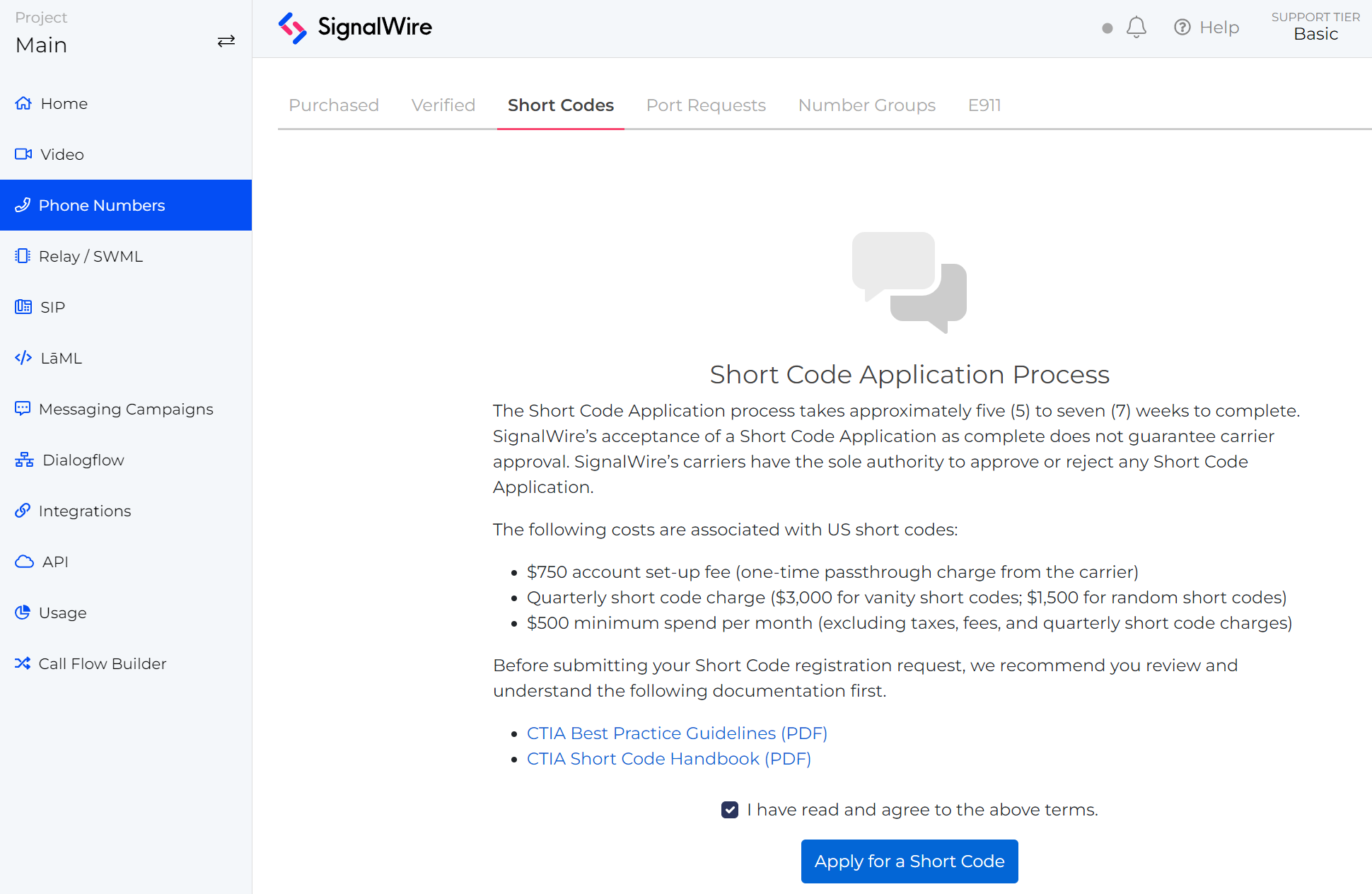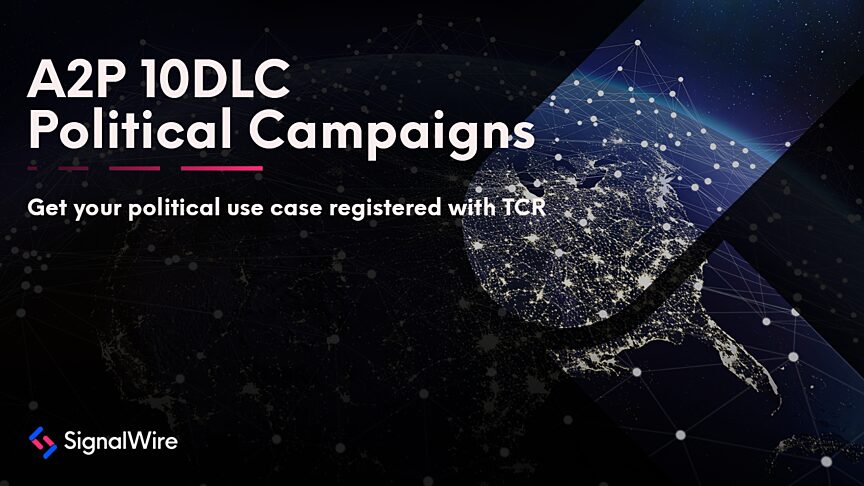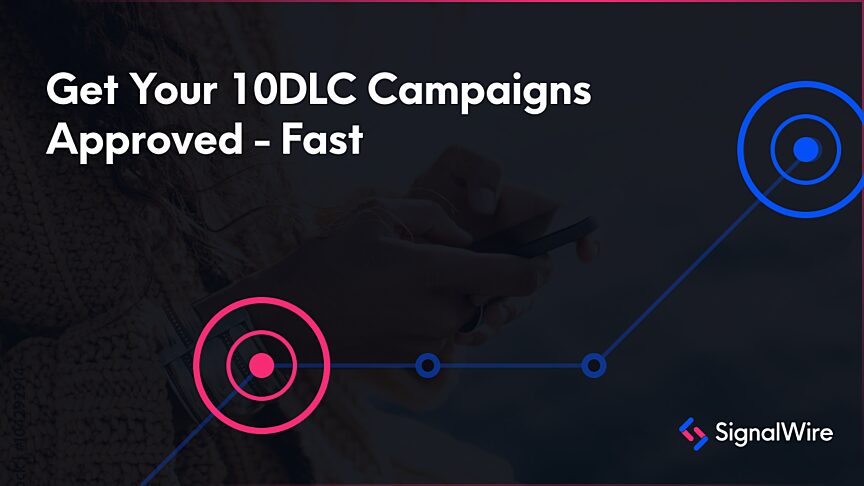What are short codes?
Short codes are 5 or 6 digit long phone numbers, as opposed to 10 digit long codes (10DLC), which are standard U.S. phone numbers. Selecting the right type of phone number is essential for the success of your SMS campaign. If you’re looking for higher throughput and deliverability (messages sending more quickly and with greater success), short codes could be the optimal choice.
Short codes are designed to send out texts faster. Depending on your traffic, sending messages with high frequency over 10DLC puts your campaign at risk of being marked as spam.
If you’re wondering if a short code would be the best choice for your campaign, we have a great guide to picking a phone number. No matter which type of phone number you choose, you can purchase and register it with SignalWire. Once you know which number is best for you, you’re ready for the next step - the registration process!
The benefits of short codes
Short codes are the best option if you need to send out hundreds of time-sensitive messages at once due to the extensive nature of the registration process.
Aesthetically, a short code is a very professional style of phone number, especially if you’re serving a wide range of areas of varying area codes. If you’re sending out tons of coupon codes, confirmation messages, or high-volume customer support conversations to a wide audience, short codes add legitimacy to your business.
If you want consumers to opt-in to a messaging campaign, it's much easier for them to text a keyword to a 5 or 6 digit number instead of a 10DLC.
The short code registration process
The short code registration process has a much longer waiting time than other styles of phone numbers such as 10DLC. You should expect to wait 5-7 weeks for approval. Wireless carriers have to approve each campaign before sending traffic over their networks. The reward for the wait, however, is that you’ll have much higher throughput and deliverability.
The good news is: you can now apply to register short codes directly in your SignalWire space! Simply navigate to short codes under phone numbers in the left-hand navigation bar. There, you will find a straightforward form where you can submit all your campaign information.
Many campaigns are not ready to be filed with carriers upon first presentation, but SignalWire is here to help with the process of ensuring a campaign is compliant.
Our carrier operations team has some great tips for making sure your registration is successful as quickly as possible, so that you don’t have to wait several months of applying and reapplying to send out your campaign.
Listed below are some best practices to follow as you fill out the registration form, so that you can get your SMS campaigns out ASAP.
Short code guiding principles
We follow CTIA guidelines in this post. To sum it up, there are four guiding principles that provide the baseline for all requirements:
Display clear calls-to-action
All calls-to-action must be clearly displayed. It is important to inform consumers about the content they are agreeing to receive. Disclosures are mainly used to ensure that consumers give their consent to receive text messages and have a clear understanding of the program.
A call-to-action may be presented verbally (i.e. point of sale), via print ad (i.e. “text JOIN to xxxxx) or via web (i.e. mobile number entry).
Requirements:
- Product description
- Message frequency disclosure
- Terms and conditions
- Privacy policy
- It must be clear that the end user’s personal information will not be shared or sold to third parties for the purpose of marketing. Only the brand that the user specifically provides consent to may send them messages. Lead generation is not permitted.
- STOP keyword
- “Message and data rates may apply”
Examples
- Text {keyword} to XXXXX to receive {type of alerts} from {brand name}.
- {Message Frequency}. Message & Data rates may apply. Terms & Conditions and Privacy Policy: {link}
Consent mechanisms (terms and conditions)
Terms and conditions can be presented in full beneath the call-to-action, or they can be accessible from a link in proximity to the call-to-action.
The brand’s terms and conditions page will be reviewed for the following criteria:
- Program name and description
- Service delivery frequency
- Product description
- Contact information
- Opt-out instructions
- “Message and data rates may apply”
- Link to Privacy Policy
- “Carriers are not liable for delayed or undelivered messages”
Examples
- [Program/Brand Name] Terms and Conditions
- [Program description]. Message and data rates may apply. For help, reply HELP. Carriers are not liable for delayed or undelivered messages.
- For our privacy policy, see here: [link to privacy policy]
Send opt-in confirmation messages
A consumer’s opt-in must be confirmed in the first message they receive from you. For a single message, the confirmation can be part of the initial message after opt-in. Clear instructions for opting out must be included in confirmation messages for programs that send recurring messages.
In order to enroll in any SMS program, whether it's a program that sends a single message or recurring messages, consumers must give their consent in writing beforehand. For recurring messages, one message must be sent to confirm that the consumer has opted in, and the option for a double opt-in is not mandatory.
Requirements:
- Consumer’s affirmative opt-in
Examples
- {Brand} Alerts: You have opted in to receive messages! Msg freq varies. Msg & Data Rates May Apply. Reply HELP for help. Reply STOP to cancel.
Acknowledge and honor opt-out requests
You must acknowledge and fulfill all opt-out requests.
If you're sending recurring messages, the opt-in confirmation must state explicitly to which program the user enrolled and provide clear opt-out instructions.
Requirements:
- Opt-In Confirmation
- Name of the product or program
- Opt-out options
- Recurring-messages disclosure
- Contact information
- “Message and data rates may apply”
- HELP
- Name of the product or program
- Contact information for customer service
- Opt-Out
- Program name
- Notification that no additional messages will be sent.
Examples
- {Brand}: You have been unsubscribed and will not receive any more messages.
Donation programs
If your SMS campaign solicits political donations, it will be subject to additional regulations. To learn more about political messaging campaigns, check out our detailed guide. Any short code campaign that asks for charitable donations is also subject to additional regulations.
If you have any questions about short code requirements or campaigns, our team is here to help! Open a ticket at any time in your dashboard, or find us on Slack to connect with our team of experts.



